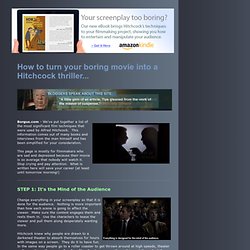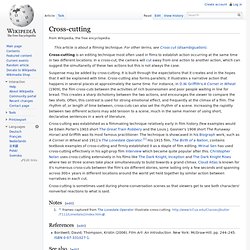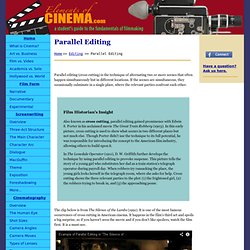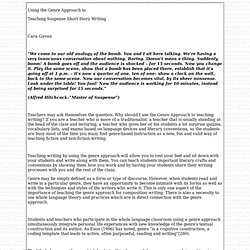

Film Techniques of Alfred Hitchcock - suspense, camera angles, style, editing, basics. Change everything in your screenplay so that it is done for the audience.

Nothing is more important than how each scene is going to affect the viewer. Make sure the content engages them and reels them in. Use the characters to tease the viewer and pull them along desperately wanting more. Hitchcock knew why people are drawn to a darkened theater to absorb themselves for hours with images on a screen. They do it to have fun. STEP 2: Frame for Emotion. Suspense Film Editing. The following article, How to turn your boring movie into a Hitchcock thriller..., was written by Jeff Bays and appears on his website Jeff Bays has generously allowed us to place excerpts of his article into our suspense section.

Enjoy, and make sure to check out the full article here. As well as the follow up article Hitchcock: Wouldn't it be funny if... Point of View Editing Jimmy Stewart looks at dog and then we see him smiling. Jimmy Stewart looks at a woman undressing and then we see him smiling. VCE Media, VELS Media, Media Arts, digital literacy, media education, filmmaking. Want to create nail-biting suspense?

Want your audience hanging on tenterhooks? Brett Lamb looks to the experts to gather some tips and techniques for creating edge-of-your-seat tension in Dial S for Suspense. Alfred Hitchcock, the master of suspense, once famously explained the feeling by describing a bomb underneath a table. If the bomb explodes, the audience is given a shock. In a suspense film, however, the audience knows there’s a bomb underneath the table.
Suspense, then, is a feeling of anxiety that accompanies uncertainty about the outcome of a scene. But suspense isn’t just a staple of horror films and thrillers. Creating a suspenseful short film is a precarious balancing act that starts in pre-production and continues until the final cut of your film. To keep reading this article pick up a copy of Screen Education, Issue 67. Creating suspense Use these techniques to ratchet up the suspense in your short films. Handheld camera movement Camera framing Point of view shots Shot size. The Kuleshov Experiment. Home >> Editing >> The Kuleshov Experiment In the dawn of the 20th century, cinema was a new art form, comprising many techniques that hadn’t been developed.

Cross-cutting. Suspense may be added by cross-cutting.

It is built through the expectations that it creates and in the hopes that it will be explained with time. Cross-cutting also forms parallels; it illustrates a narrative action that happens in several places at approximately the same time. For instance, in D.W. Griffith's A Corner in Wheat (1909), the film cross-cuts between the activities of rich businessmen and poor people waiting in line for bread. This creates a sharp dichotomy between the two actions, and encourages the viewer to compare the two shots. Cross-cutting is sometimes used during phone-conversation scenes so that viewers get to see both characters' nonverbal reactions to what is said. Notes[edit] References[edit] Film Techniques of Alfred Hitchcock - suspense, camera angles, style, editing, basics. PDF/Elements_of_suspense.pdf. What is parallel editing, cross cutting? Home >> Editing >> Parallel Editing Parallel editing (cross cutting) is the technique of alternating two or more scenes that often happen simultaneously but in different locations.

If the scenes are simultaneous, they occasionally culminate in a single place, where the relevant parties confront each other. The clip below is from The Silence of the Lambs (1991). It is one of the most famous occurrences of cross cutting in American cinema. It happens in the film's third act and spoils a big surprise, so if you haven't seen the movie and if you don't like spoilers, watch the film first. Why use it? To add interest and excitement to an otherwise boring scene. A woman takes a shower, singing gaily. A woman taking a shower, singing, and dressing up are not particularly exciting. Alfred Hitchcock - The Master of Suspense. Thriller and Suspense Films. Thriller and Suspense Films: These are types of films known to promote intense excitement, suspense, a high level of anticipation, ultra-heightened expectation, uncertainty, anxiety, and nerve-wracking tension.

Thriller and suspense films are virtually synonymous and interchangeable categorizations, with similar characteristics and features. If the genre is to be defined strictly, a genuine thriller is a film that rentlessly pursues a single-minded goal - to provide thrills and keep the audience cliff-hanging at the 'edge of their seats' as the plot builds towards a climax. The tension usually arises when the main character(s) is placed in a menacing situation or mystery, or an escape or dangerous mission from which escape seems impossible. Life itself is threatened, usually because the principal character is unsuspecting or unknowingly involved in a dangerous or potentially deadly situation.
Short Story Suspense. Using the Genre Approach to Teaching Suspense Short Story Writing Cara Gavan “We come to our old analogy of the bomb.

You and I sit here talking. We're having a very innocuous conversation about nothing. (Alfred Hitchcock–“Master of Suspense”) Teachers may ask themselves the question: Why should I use the Genre Approach to teaching writing? Teaching writing by using the genre approach will allow you to rest your feet and sit down with your students and write along with them. Genre may be simply defined as a form or type of discourse.
Students and teachers who participate in the whole language classroom using a genre approach simultaneously integrate personal life experiences with new knowledge of the genre's textual construction and its author.